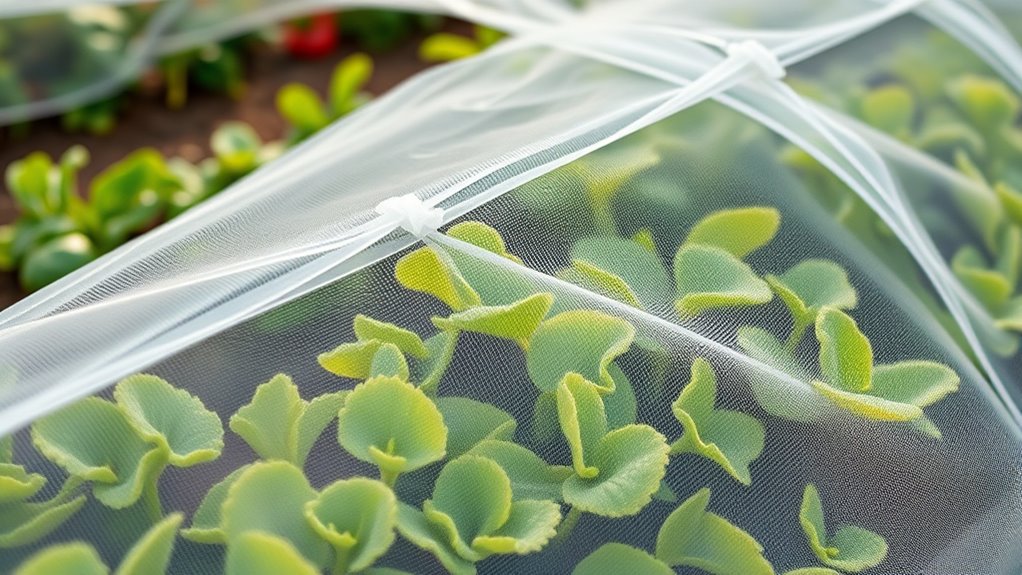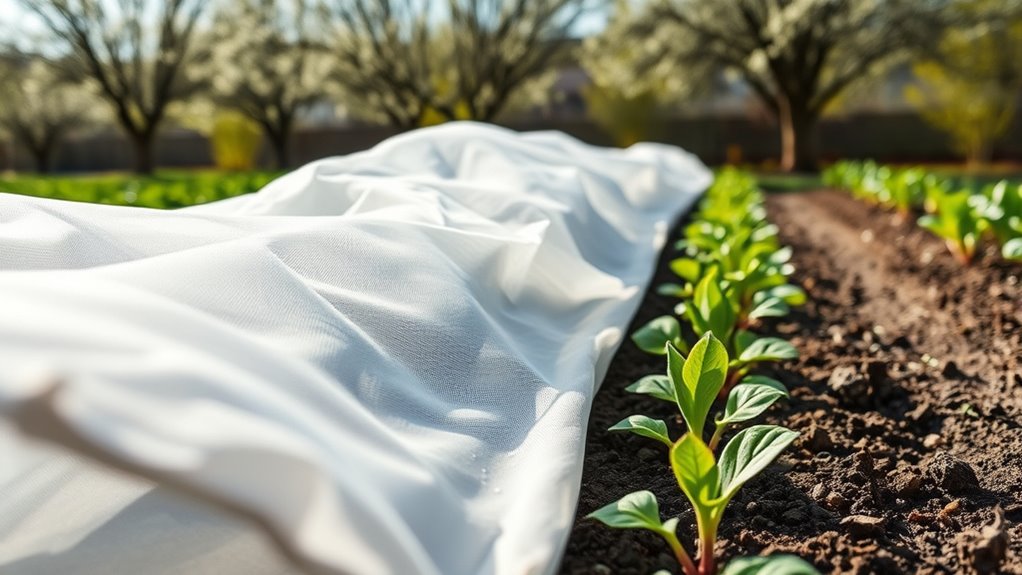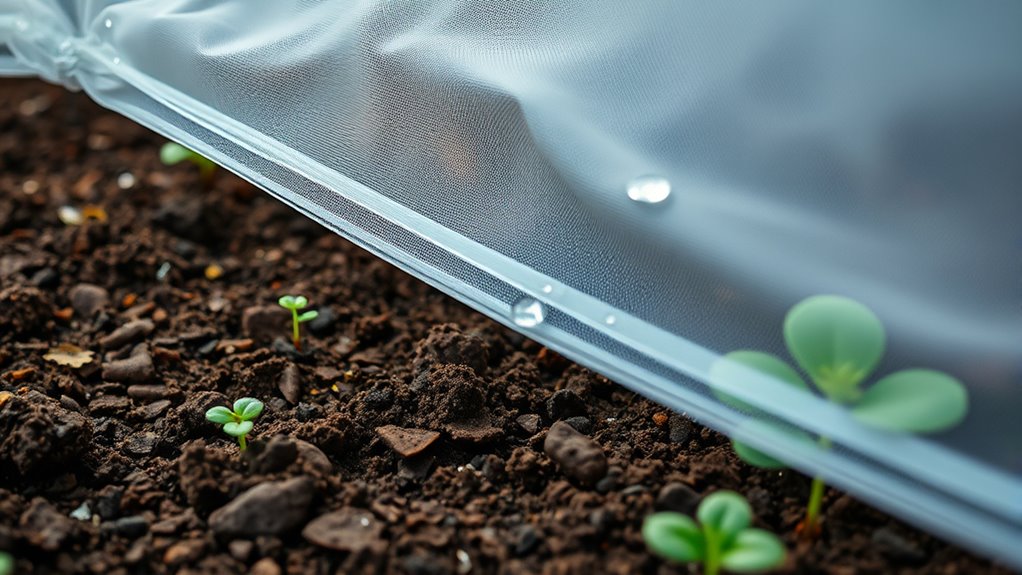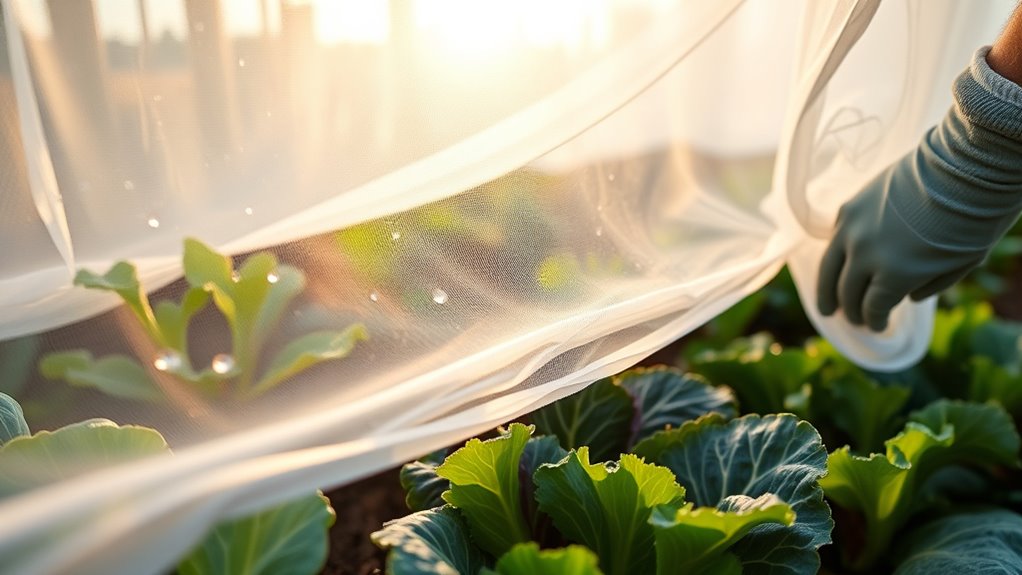To effectively use row covers for early-season pest exclusion, select breathable fabric with small mesh sizes to block tiny pests like aphids and whiteflies. Install covers before pests emerge, securing edges tightly with soil or stakes, and guarantee good airflow to prevent moisture buildup. Remove covers when plants are strong or pests are under control, reapplying them as needed. With proper timing and installation, you’ll protect your crops and promote healthy growth—plus, you’ll discover more tips to optimize your setup.
Key Takeaways
- Install lightweight, breathable row covers early in the season before pests emerge to prevent infestation.
- Choose mesh sizes suitable for blocking tiny pests like aphids and whiteflies.
- Secure cover edges with soil, rocks, or staples to prevent gaps and pest entry.
- Monitor covers daily for tears or damage, and repair promptly to maintain effectiveness.
- Remove covers during suitable weather and pest pressure lows to promote airflow and plant health.
Selecting the Right Row Cover Material

Choosing the right row cover material is essential for effective pest exclusion and healthy plant growth. When selecting materials, consider factors like mesh size, durability, and breathability. Fine mesh fabrics block tiny pests such as aphids and whiteflies, ensuring your plants stay pest-free. Heavier fabrics offer added durability, protecting against harsh weather while still allowing light and air to pass through. Lightweight options might be easier to handle, but they can tear more easily, reducing their effectiveness. Your goal is to pick a material that provides a physical barrier without compromising plant health. Proper materials selection directly impacts pest exclusion success and the overall productivity of your garden. Sound vibrations are believed to enhance cellular regeneration and overall health, so choosing breathable fabrics that promote good airflow can support plant vitality. By choosing wisely, you create a protective environment that promotes strong, healthy plants.
Timing Your Deployment for Maximum Effectiveness

Timing is critical when deploying row covers to guarantee you get the maximum pest exclusion benefits. You should install covers early in the season, before pests become active. Monitoring local pest emergence dates helps you determine the best window for deployment. Proper cover material selection impacts how quickly and effectively pests are kept out; lightweight fabrics warm plants while blocking pests. Avoid delays that allow pests to establish, as late coverage reduces effectiveness. Strategic pest exclusion depends on timing, ensuring that vulnerable seedlings are protected during their most susceptible stages. By planning your deployment carefully, you maximize the protective benefits of your covers, reduce pest pressure, and promote healthy plant growth. Consistent timing and the right cover material are key to successful pest exclusion strategies. Additionally, understanding the signs of spoilage in your materials can help maintain effectiveness and prevent introducing unwanted pests or diseases.
Preparing Your Garden Bed for Cover Installation

Before installing your row cover, make sure to clear away debris and weeds to create a clean space. Level and firm the soil so the cover stays secure and doesn’t sag. Finally, mark your bed boundaries clearly to keep everything organized during installation.
Clear Debris and Weeds
Clearing debris and weeds from your garden bed is an essential first step before installing row covers. Removing plant material reduces hiding spots for pests and makes pest identification easier. Weeds can compete with your crops for nutrients, impacting soil fertility, so clearing them helps guarantee healthier plants. Take time to thoroughly remove weeds, especially any that may harbor pests or diseases. Clearing debris also prevents pests from overwintering in mulch or fallen leaves, reducing early-season infestations. By starting with a clean bed, you create a more controlled environment for your crops and make pest exclusion via row covers more effective. Additionally, understanding Gold IRA Rollovers can help you diversify your overall investment strategy for future financial security. This step sets a solid foundation for protecting your plants and maintaining a healthy, productive garden throughout the season.
Level and Firm Soil
To make certain your row covers function effectively, you need to level and firm the soil in your garden bed. Uneven or loosely packed soil can lead to gaps that pests can exploit. Use a rake or garden leveler to smooth out high spots and fill in low areas, creating a flat surface. Firm the soil by pressing down with a tamper or the back of your rake handle, reducing soil compaction and providing stability for the cover. Properly leveled and firm soil helps improve moisture retention, ensuring your plants stay hydrated and healthy. It also prevents shifting or collapsing of the cover during windy conditions. Taking these steps sets a solid foundation, making pest exclusion more effective and protecting your early-season crops. Additionally, incorporating proper soil preparation techniques can enhance overall plant health and yield.
Mark Bed Boundaries
Once your soil is leveled and firm, it’s time to clearly define your garden bed boundaries. Bed boundary marking helps you stay organized and guarantees your row covers fit properly. Use stakes, string, or garden markers to outline the edges of your planting area. Precise boundary marking is essential for effective pest exclusion techniques, as it prevents pests from sneaking in around the cover’s edges. Accurate boundaries also help you install row covers smoothly, reducing gaps where pests can enter. Take your time to measure and mark carefully, ensuring the cover will sit snugly over the bed. Properly marked boundaries set a solid foundation for pest exclusion, protecting your plants from early-season pests while making maintenance easier. Being aware of affiliate disclosures and privacy policies can help you make informed decisions about online gardening resources and tools.
How to Properly Install Row Covers

To install row covers effectively, you need to choose the right material that fits your plants and climate. Make sure to secure the edges well to prevent pests from sneaking in and to keep the cover stable during windy days. Proper installation guarantees your plants stay protected and healthy throughout the season. Additionally, considering celebrity lifestyle insights can inspire creative ways to design your garden space.
Selecting the Right Material
Choosing the right material for your row covers is essential for effective pest exclusion and plant health. Start by evaluating fabric choices based on light transmission, breathability, and durability. Lightweight materials allow sunlight and airflow, promoting healthy growth, but may need to be replaced more often. Heavier fabrics provide better pest protection but can reduce light and airflow, potentially affecting plants. Cost considerations also play a role; more durable fabrics might cost more initially but last longer. Consider your specific crops and local climate when selecting fabric choices to ensure your plants stay protected without sacrificing growth. Remember, the right material balances pest exclusion, plant health, and budget, setting the foundation for a successful early-season garden.
Securing Edges Effectively
Properly securing the edges of your row covers is essential to prevent pests from sneaking underneath and to keep the covers in place during wind or rain. To do this, carefully drape the cover material over your garden bed, ensuring it fully covers all sides. Use soil, rocks, or staples to weigh down the edges, creating a tight seal that pests can’t penetrate. If your cover material is lightweight, consider using hoops or stakes to lift the cover slightly and secure the edges more effectively. Avoid gaps or loose sections, as pests can enter through these openings. Properly installed edges will also withstand weather changes, providing consistent protection for your crops throughout the early season. For added assurance, choosing high-quality skincare ingredients can enhance the longevity and effectiveness of your pest exclusion efforts.
Managing Ventilation and Climate Control Under Covers

Managing ventilation and climate control under row covers is essential to prevent excess heat, humidity, and moisture buildup that can promote disease and pest problems. Proper airflow helps you maintain ideal growing conditions and reduces the risk of pests thriving beneath the covers. Regular cover maintenance is vital; inspect for gaps or tears that may restrict ventilation and allow pests to enter. When managing climate, monitor temperature and humidity levels to avoid creating a damp environment that encourages fungal growth. Utilizing breathable fabrics can enhance airflow and reduce moisture retention under the covers. Good pest identification becomes easier when the environment stays controlled, making it simpler to spot early signs of pest activity. By keeping covers in good condition and ensuring proper ventilation, you create a healthier growing environment that minimizes pest pressure and supports plant health.
Monitoring and Adjusting Covers Throughout the Season

Regularly monitoring your row covers throughout the season helps catch emerging pest issues early and guarantees your climate control remains effective. Check for signs of wear that could compromise cover durability, such as tears or holes. Make certain pest exclusion is maintained by inspecting for gaps or loose edges. Keep an eye on the overall condition of the covers and adjust or reinforce as needed. Here are four key steps:
- Examine covers daily for tears or damage.
- Confirm all edges are sealed tightly.
- Adjust covers to prevent sagging that exposes plants.
- Replace or repair covers showing significant wear to maintain pest exclusion.
Consistent monitoring ensures your covers stay effective, protecting your crops from pests while allowing proper airflow and temperature regulation. Regular inspections also help identify potential failure points, ensuring that the covers continue to function as intended throughout the season.
Removing and Replacing Covers for Plant Care

Knowing when to safely remove your row covers is essential to avoid damaging your plants. You should also learn proper techniques to reinstall them quickly and securely. This guarantees your plants get the care they need while staying protected from pests. Additionally, incorporating vertical storage solutions can help organize your gardening tools and supplies, making it easier to manage your garden space efficiently.
Safe Cover Removal Timing
Timing is crucial when removing and replacing row covers to guarantee your plants stay healthy and protected. You want to balance pest exclusion effectiveness with plant needs. Consider these factors:
- Monitor weather forecasts; avoid removing covers during cold snaps or rain.
- Check plant growth stages; remove covers once plants are strong enough to withstand pests.
- Assess pest activity; remove covers when pest pressure is low or under control.
- Evaluate cover material selection; ensure your cover is breathable and suitable for maintaining ideal conditions.
Proper timing helps prevent stress on plants and ensures pest exclusion remains effective. Removing covers too early can invite pests, while waiting too long might hinder plant growth. Stay attentive to these cues for the best results.
Proper Cover Reinstallation Techniques
To guarantee your plants stay protected and healthy, mastering proper cover reinstallation techniques is essential. First, ensure you select the right cover material for your needs, considering factors like breathability and durability. When reinstalling, handle the cover carefully to avoid tears or damage. Use proper installation techniques by securing the edges firmly with stakes, clips, or weights to prevent wind from displacing the cover. Be sure to check that there are no gaps or loose spots where pests could enter. Keep the cover taut but not overstretched, allowing airflow and preventing mold. Regularly inspect the reinstalled cover for wear or damage, and reseat or replace it as needed. Proper reinstallation maintains pest exclusion while supporting healthy plant growth.
Combining Row Covers With Other Pest Management Strategies

Combining row covers with other pest management strategies can considerably enhance your garden’s defenses. By integrating multiple methods, you reduce pest resistance and promote beneficial insects that naturally control pests. Here are four effective strategies:
- Encourage Beneficial Insects – Plant flowers nearby to attract ladybugs and parasitic wasps that target pests.
- Practice Crop Rotation – Change planting locations yearly to disrupt pest life cycles.
- Use Trap Crops – Grow sacrificial plants to lure pests away from your main crops.
- Apply Organic Sprays – Use targeted sprays like neem oil to supplement physical barriers without harming beneficial insects.
This integrated approach helps maintain healthy plants while minimizing chemical reliance.
Troubleshooting Common Issues With Row Covers

While row covers are effective for early-season pest exclusion, they can sometimes present issues that disrupt your garden’s progress. One common problem is difficulty with pest identification—if pests still appear, check for small holes or tears in the cover. Damage often results from weather or wildlife, so inspecting cover durability regularly helps catch issues early. Rips or weakened fabric allow pests to slip through, so repair or replace damaged sections promptly. Additionally, ensure the cover is properly secured to prevent pests from crawling underneath. If plants seem to be overheating or suffocating, consider adjusting the cover’s height or ventilation. Addressing these issues quickly keeps your pest exclusion effective and maintains healthy plant growth throughout the season.
Extending the Growing Season With Row Covers

Extending the growing season is one of the key benefits of using row covers, allowing you to start planting earlier in spring and continue harvesting later into fall. With row covers, you can protect crops from late frosts and extend warm weather growth. To maximize this benefit, consider these steps:
- Plant cold-tolerant crops early under covers to jumpstart growth.
- Remove covers during hot periods to prevent overheating and promote soil fertility.
- Rotate crops seasonally to prevent soil depletion and maintain healthy soil structure.
- Use cover crops in fall to improve soil fertility for the next planting cycle.
Frequently Asked Questions
Can Row Covers Protect Against All Types of Pests?
You might wonder if row covers protect against all pest types. While cover effectiveness varies, they do a great job of blocking many pests like insects, beetles, and some birds. However, they might not keep out larger pests or those that can crawl under or through gaps. So, while row covers reduce many pest problems, they aren’t foolproof against every pest type.
How Do I Store Row Covers During Off-Season?
Thinking ahead about your row covers? Proper cover storage tips are essential for off-season maintenance. You should gently clean them to remove dirt and debris, then fold them neatly to prevent creases. Store your covers in a cool, dry place away from direct sunlight, ideally in breathable containers or on shelves. This careful approach guarantees they stay in good shape, ready for effective use when the new season begins.
Are There Any Plants That Shouldn’t Be Covered?
Some plants aren’t suitable for row covers because of plant compatibility issues or the cover material. For example, tall or sprawling plants may get crushed or restricted, and delicate or sensitive plants could suffer from moisture buildup or poor airflow. Always consider the cover material selection to guarantee it’s breathable and appropriate for your specific plants. Check plant requirements before covering, so you don’t hinder their growth or health.
What Are the Best Methods for Removing Pests From Covers?
Imagine you’re back in a time when pest control meant battling invaders with ingenuity. When removing pests from covers, start with gentle pest detection methods like inspecting edges and corners. Use cover removal techniques such as lifting carefully to avoid damaging plants, then manually remove visible pests or spray with a gentle, organic solution. Regular checks and early detection help keep pests at bay without harming your precious crops.
How Do Row Covers Impact Plant Pollination?
You might wonder how row covers affect plant pollination. They serve as pollination barriers by preventing insects from reaching flowers, which can reduce natural pollination. While insect exclusion protects plants from pests, it may also limit beneficial pollinator access. To guarantee good pollination, you can remove the covers during flowering or manually pollinate. This way, you balance pest control with effective pollination for healthy crop production.
Conclusion
Using row covers can boost your early-season garden success by up to 50%, shielding plants from pests and harsh weather. When you choose the right material and install them correctly, you’ll see healthier plants and longer growing seasons. Remember to manage ventilation and combine covers with other strategies for best results. With proper use, you can enjoy a thriving garden well before the last frost, making your gardening efforts more rewarding.









